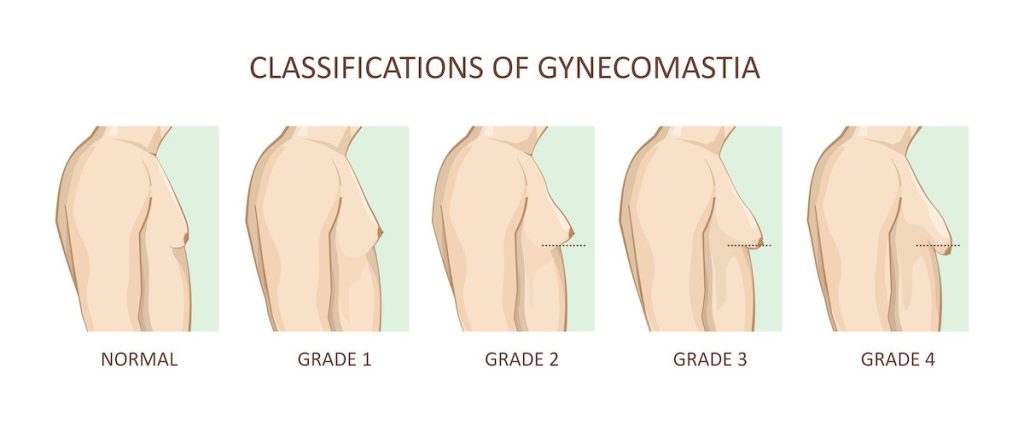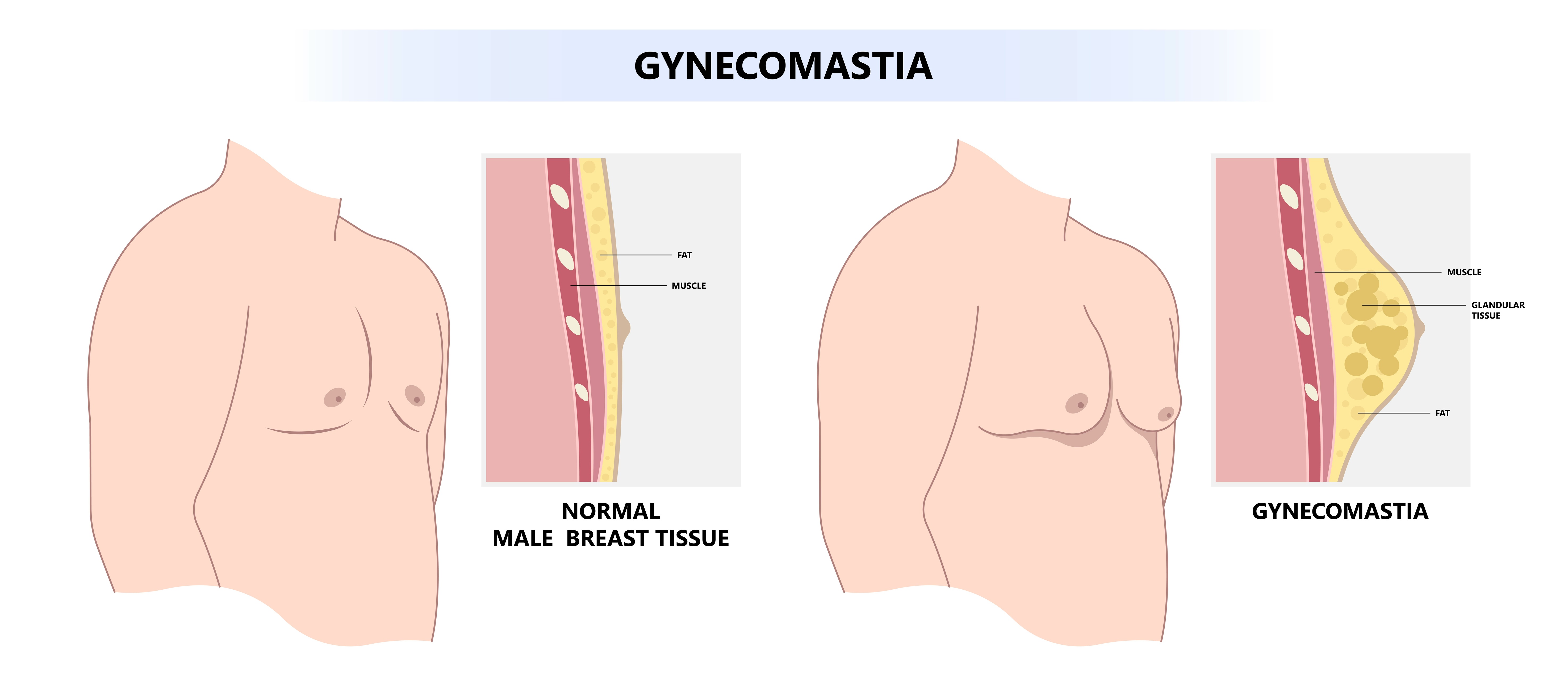Have you ever experienced a strange sensation of your body seemingly playing tricks on you? Perhaps, as an adolescent boy or man, noticing Gynecomastia grades developing. That odd feeling of your chest area expanding. Shirts get tighter, and embarrassment creeps up whenever you have to take off your shirt at the beach.
I get it… It’s not just about how it looks but also how it makes you feel – uncomfortable and self-conscious. But what if I told you that understanding this condition could be your first step towards reclaiming control?
This blog will unravel the mystery behind different gynecomastia grades – from mild breast enlargement to severe conditions needing surgical intervention. We’ll delve into symptoms and causes tied to each grade while exploring non-surgical and surgical treatment options.
We’re ready to roll!
Table Of Contents:
- Understanding Gynecomastia Grades
- The Four Grades of Gynecomastia
- Symptoms and Causes Associated with Different Grades
- Non-Surgical and Surgical Treatment Options
- Factors Affecting Treatment Approach
- Conclusion
Understanding Gynecomastia Grades
Gynecomastia, a condition characterized by the enlargement of male breast tissue, can be daunting for those affected. However, understanding its grades and how they relate to hormonal imbalances in pubertal and adolescent males can shed some light on this issue.
The classification system for gynecomastia has four primary grades: Grade I (mild), Grade II (moderate), Grade III (severe), and Grade IV (marked). Each grade reflects the severity of the condition, with factors like skin excess, breast size, and chest area involved in determining these classifications.
Grade I, or mild gynecomastia, typically shows small increases in breast tissue around the areola without significant skin excess. The classification systems for gynecomastia highlight that pubertal gynecomastia often falls into this category.
Grade II, considered moderate forms, includes two subcategories: A) minor increase with no extra skin; B) more visible but not severe enlargement with minor skin redundancy. These stages may result from hormone imbalances during puberty or illicit drug use such as anabolic steroids consumption.
Moving up to Grade III, we encounter severe cases with notable breast development and clear redundancies in surrounding skins, which mimic female breasts’ appearance. This grade is commonly associated with chronic conditions where intervention becomes necessary due to discomfort or psychological distress experienced by patients.
Last but certainly not least comes Grade IV. At this stage, marked enlargements similar to large female breasts occur alongside significant amounts of excess skin, contributing heavily towards body dissatisfaction among individuals experiencing it.
These grades serve as guidelines for medical professionals to decide the best course of action. Bear in mind that even though it can be upsetting, gynecomastia is widespread among teenage boys and usually goes away on its own for 75 to 90% of cases within 1-3 years.

Treatment Options
Choosing the right treatment hinges on various things. We’re talking about the grade of your condition, among other aspects.
The Four Grades of Gynecomastia
Understanding the grades of gynecomastia is key to finding effective treatment. Let’s delve into each grade, from mild to marked enlargement.
Mild Gynecomastia (Grade I)
This condition starts with a small increase in breast tissue around the nipple area. Grade I, or mild gynecomastia, typically involves minor skin excess and no sagging chest appearance. The condition may not be immediately noticeable, especially under clothing.
Frequently observed among pubertal boys due to hormonal changes, it usually resolves naturally over time – statistics show that up to 90% of cases resolve within three years. However, some adult men can also experience this form of breast enlargement.
Moderate Gynecomastia (Grade II & IIA)
In moderate gynecomastia, there’s more pronounced growth in breast tissue and possible skin redundancy depending on whether it’s grade II or IIA. Men experiencing these stages might feel self-conscious about their chest area since these forms are more visible than grade I.
Certain lifestyle factors like using anabolic steroids or consuming illicit drugs could trigger this level of severity, too – another reason why awareness is important.
Severe Gynecomastia (Grade IIB & III)
Sufferers at this stage witness the significant expansion of female-like breasts and substantial amounts of excess skin. This change often results from major weight fluctuations or certain health conditions that cause hormone imbalances, such as liver disease or tumors secreting estrogen hormones.
Grade IIB and III gynecomastia usually require surgical intervention, as it rarely resolves independently.
Marked Enlargement (Grade IV)
At this point, the most severe grade of gynecomastia, known as Grade IV, shows up. Here’s where male breasts start to look similar to female ones in size and shape.
Symptoms and Causes Associated with Different Grades
Gynecomastia grades can cause various symptoms, from minor skin excess to severe breast enlargement. Let’s explore the specifics of each grade.
Grade I: Mild Gynecomastia
In Grade I gynecomastia, men often notice slight breast tissue enlargement. It’s generally characterized by glandular tissue that causes puffy nipples or dense breast tissue but no significant skin redundancy.
Fatty tissue might also contribute to this condition in some cases. The common causes include hormonal imbalances caused by age or using certain medications like Clomiphene.
Grade II & IIA: Moderate Gynecomastia
Moderate gynecomastia is split into two subgrades – Grade II and IIA. Both show more pronounced signs than mild cases, such as enlarged breasts and the potential for minor skin excess around the chest area.
The most frequent triggers are similar to those seen in milder forms – hormones, drugs (prescription or illicit), weight gain, etc., but they could be intensified due to factors like prolonged use of anabolic steroids.
Grade IIB & III: Severe Gynecomastia
The next stage involves even greater breast enlargement and noticeable amounts of redundant skin forming folds on the chest surface akin to female breasts. Observation and reassurance are the safest treatment options for pubertal gynecomastia linked with these grades (Tamoxifen). However, if left untreated over time, it could lead to more severe cases requiring surgical intervention.
Grade IV: Marked Enlargement
use of certain drugs. The size and shape can often be compared to female breasts due to the significant tissue growth. These conditions are usually a result of prolonged hormonal imbalances or medication side effects.
Non-Surgical and Surgical Treatment Options
The first line of defense against gynecomastia often involves non-surgical treatments. These primarily include pharmacological interventions that aim to correct the estrogen-androgen imbalance, typically at the root of this condition.
Pharmacological Treatments
Raloxifene, Danazol, and Anastrozole are common drugs used in treating gynecomastia. But it’s important to remember that their effectiveness varies from person to person, especially among adolescents where data on efficacy is limited.
Treating gynecomastia with medication might sound easy, but remember that these medicines come with potential side effects. It’s important to converse with your medical provider about any worries concerning the potential risks before beginning treatment.
Surgical Treatments
If medications don’t provide enough relief or if a patient has more severe breast enlargement or skin excess due to higher-grade gynecomastia, surgical options may be considered as part of an effective treatment plan.
Cosmetic surgeons often use liposuction to remove excess fat tissue from the chest area. This technique can help sculpt the male chest contour and improve appearance significantly.
In some cases, though, liposuction alone isn’t enough—especially when there’s substantial glandular breast tissue involved rather than just fatty deposits—a situation often seen in bodybuilders who use anabolic steroids. The higher the gynecomastia grades, the more likely skin excision will be needed.
- A surgical excision might be necessary to remove this denser breast tissue. This procedure involves making a small incision around the edge of the areola or within the chest’s natural creases to minimize visible scarring.
- For severe cases involving significant skin redundancy, more advanced excisional techniques may be required that can include additional incisions and potential nipple repositioning.
Our team at GynecomastiaLA includes board-certified cosmetic surgeons. They’ve honed their skills in gynecomastia surgery, providing top-notch care to every patient.

Factors Affecting the Treatment Approach
The treatment approach for gynecomastia grades is tailored to the individual based on factors such as age groups and body types. Various factors, including age groups and body types, shape it.
Age Groups
Youthful bodies often bounce back quicker after surgery due to their higher skin elasticity. Pubertal gynecomastia is self-limited in 75 to 90% of adolescents and regresses over 1 to 3 years. Hence, it’s best treated with observation and reassurance instead of jumping right into surgical options.
Middle-aged or older patients may need more attention during recovery because their skin tends not to retract as efficiently post-surgery.
Body Type
A patient’s overall physique also influences the type of care they receive. For instance, an individual who falls within a healthy weight range will have different needs from someone dealing with obesity-related gynecomastia. The American Society of Plastic Surgeons recommends personalized health care plans for these differences.
Skin Elasticity
Skin quality plays a critical role, too. Firm skin typically shrinks well following breast tissue removal. In contrast, loose or excess skin might require additional procedures such as mastopexy (breast lift) or even more complex techniques, depending on severity. This factor should be considered when determining enlargement grade and subsequent treatment paths.
Bilateral Gynecomastia vs Unilateral Gynecomastia Grades:
- Bilateral gynecomastia – this occurs when both breasts are enlarged; the treatment approach can be more complicated as it involves addressing both sides.
- Unilateral gynecomastia – this is when only one breast is enlarged. The board-certified plastic surgeon has to make sure that the result looks symmetrical and natural.
Severity of Condition
Not only does the severity or grade of gynecomastia matter, but it also significantly influences how we approach treatment. Understanding this helps us craft a more effective plan for each individual.
Conclusion
- Understanding gynecomastia grades is your first step toward regaining control. The varying degrees, from mild breast enlargement to severe conditions needing surgical intervention, shed light on the severity of this condition.
- Glandular tissue enlargement and skin redundancy are just a few symptoms accompanying different stages. But remember, hormonal imbalance during puberty or aging could be at play here.
- Depending on the severity of gynecomastia, treatment options may range from pharmacological treatments to surgical techniques such as liposuction or excision.
- The journey might seem overwhelming initially, but knowing what’s happening can make it more manageable. And while every case is unique in its own way, knowledge about these key aspects will guide you through understanding and managing this condition better!
Contact Us
If you’re concerned about gynecomastia and would like to learn more, contact our office to set up a consultation with Dr. Moein. Call today to schedule: (310) 299-9106.

Dr.Babak Moeinolmolki
LA Cosmetic Surgeon Dr. Moein is board-certified by the American Board of General Surgery.
